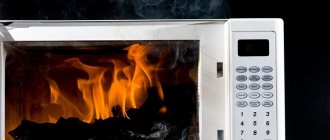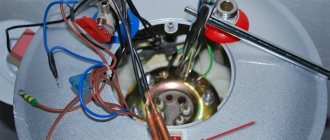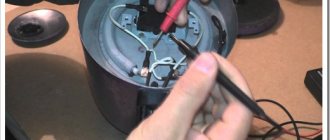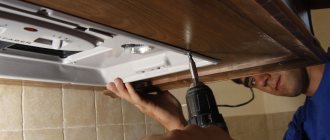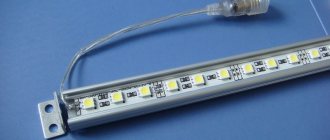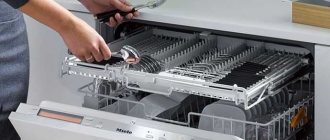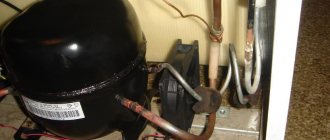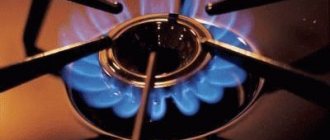Why problems might arise
As usual, the causes of microwave oven breakdowns lie in non-compliance with operating instructions. This accounts for most of the problems with household appliances and this case is no exception. Most often, problems begin after:
- There is a metal object in the chamber during heating/defrosting/cooking. Most often this is a spoon or fork that is in a container with food. At the same time, the microwave begins to spark, and then begins to act up - it sparks and does not heat the food.
- Another fairly common situation that often leads to breakdowns is heating in a closed container not intended for this purpose. When a certain temperature is reached, the dishes explode, food scatters throughout the chamber, clogging the oven parts. It is rare that such an incident remains without consequences (washing the camera does not count).
The arrangement of parts may be like this
Cheap stoves can often break down. They are made in such a way that they are repaired less often and new ones are purchased more often. And the last obvious reason is wear of parts. If your stove has been in service for a decent number of years, most likely the parts have simply exhausted their working life. As you can see, there are not many technical reasons. Basically these are erroneous actions of “users”. The result is that the microwave does not heat or does not turn on at all.
Microwave device
To make it easier to repair a microwave oven, let’s get acquainted at least in general terms with its structure. What interests us most is its “insides.”
Microwave oven device
The magnetron produces microwaves. It is connected to the camera by a rectangular waveguide. In some models, the waveguide is covered with a piece of mica (a gray-brown material similar to metal), in others it is covered with a plastic cover. The magnetron is powered by a transformer, capacitor and diode. The power supply circuit often contains a high-voltage fuse that protects the transformer from overload.
There is a fan to cool the magnetron. Warm air from the magnetron also enters the working chamber through the air duct, which speeds up the heating of food. Steam and excess air are removed from the chamber through special holes that do not allow radiation to pass through.
Microswitches for locking the closed door
To prevent the microwave oven from working with the door not tightly closed, locking microswitches are installed. As long as their buttons are not pressed (the doors are not closed), power is not supplied. When the door is opened, the power circuit is interrupted instantly. One of the reasons that the microwave oven does not turn on is the breakdown or sticking of these small parts.
The number of microswitches depends on the model. There can be from 2 to 5 pieces. Some manufacturers also use them in the start button and power control circuits. So one of the reasons why the microwave does not heat may be damage to the microswitch in the power control circuit.
An incandescent lamp is installed in the chamber for lighting. Most often it is located inside the air duct.
Operating modes are set from the control panel. It may contain electromechanical switches, or it may be based on a microprocessor. Digital control can again have options: there may be regular buttons that select the mode, or there may be a touch panel. If a problem occurs with the controls, it is better not to get into electronics without knowledge and skills. The only thing you can check is how well the conductors are holding. Everything else is only possible if you have the appropriate experience.
The microwave does not heat: simple reasons
There are situations when you put food on to warm up, everything seems to work, but even after a long period of time, the temperature of the food is insufficient or it is completely cold. The reason that the microwave does not heat can be either a serious breakdown or easily fixable reasons. Let's start with the easy one:
- The microwave oven may not heat properly due to low line voltage. For normal operation of the magnetron, 220 V is required. If the voltage is lower, it will work, but the temperature will rise very slowly. The situation is treated by installing a stabilizer. Naturally, it is better at the entrance to a house or apartment, but you can install a small stabilizer only on this equipment.
If your microwave doesn't heat, you'll have to have it repaired.
All other reasons are more serious and must be dealt with separately.
The microwave does not heat well, does not heat at all, or heats “every once in a while”
1. If the voltage in the network is less than 210 Volts, the power of microwave radiation is reduced. This is especially true for summer cottages and rural areas. Due to the reduced voltage, it takes several times longer to heat up, or the microwave heats up “every time”. 2. The malfunction may be related to the control circuit - timer or control unit. 3. The malfunction may be related to power circuits - high-voltage transformer, high-voltage fuse, high-voltage diode, capacitor or magnetron. 4. In inverter microwave ovens, the malfunction may be due to the failure of the inverter.
Diagnostics and troubleshooting:
1. Check the voltage in the electrical network. When the voltage drops below 215 Volts, the microwave oven weakly heats the food; when the voltage returns to normal, the microwave oven will work as before.
2. If the voltage is normal, then it’s time to replace the magnetron with a new one.
What to do to avoid Magnetron failure? The causes of magnetron failure most often occur if:
- During operation, the oven chamber was empty, without products, sparking occurs, which leads to damage to the magnetron.
- There was a metal object inside the oven while the oven was operating.
- Natural wear of the magnetron, loss of emission.
More serious reasons
In this section, we will look at damage that can lead to the microwave not heating, although everything is spinning/lit. To restore performance is more difficult than in the previous paragraph, but not so much that it is impossible to do it yourself.
Approximate location of parts in a microwave oven
Fuse
Sometimes the microwave does not heat due to a faulty fuse in the magnetron power circuit. It is not available in all models, but it can cause the magnetron to not work. This fuse is sometimes installed openly, but most often in a protective casing (see photo), since it is located in a high-voltage circuit.
High-voltage fuses in microwave ovens can be placed in a protective casing
It consists of a glass flask with metal caps installed at the edges. Inside there is a spring-loaded wire soldered at one edge to the cap contact. Unlike conventional fuses, the wire does not burn out in this one. During prolonged operation, the solder heats up and softens, and the elastic force of the spring separates the contacts.
Structure of a high-voltage fuse
If the fuse does not ring and a break in the circuit is visually visible, there are two ways to solve the problem - replace it or restore the soldering. To restore the high-voltage fuse, you must carefully remove the metal cap from the side from which the wire was unsoldered and solder it in place. Return the cap to its place and check whether it is heating or not.
Magnetron problems
There are several damages associated with the magnetron. Let's start again with the simplest thing - weak contacts. Wires from the filament winding of the transformer come to the terminals (connector) of the magnetron. They should be difficult to remove. It is possible that the contact has worsened due to heating. It can be improved by additionally crimping the contacts with pliers.
Read also: Galvanic coating method
Sometimes the microwave does not heat due to damage to the magnetron antenna cap. If the cap is simply blackened or there is a frozen drop of metal on it, but there are no extra holes, you need to clean everything down to bare metal and make the surface smooth. You need to work with fine sandpaper. We achieve maximum effect - everything should be even/smooth, preferably to a mirror shine. But don't rub the metal to holes. Upon completion of work, carefully remove all dust. The best way to do this is with a vacuum cleaner.
Antenna cap is damaged
If the cap is melted - as in the photo above, you need to make sure that the magnetron itself is not damaged and that a vacuum is maintained in the middle. To do this, carefully remove the cap and inspect what’s underneath. If the metal is intact, you can simply replace the cap. If not, you will have to change the magnetron, but at the same time you need to think about the feasibility of such a repair - the price of this spare part is high, perhaps you should just buy a new furnace.
How to replace the magnetron cap? It is very difficult to find it on sale - it costs a penny and is not profitable to sell. There is an option - turn it on a lathe. If this method does not suit you, you can make one from an old electrolytic capacitor of a suitable size.
Old damaged cap and new one from the capacitor
We select an element of a suitable diameter, cut off the required piece of the body, and carefully drill a hole in the center. The match in all sizes must be perfect. After this, we clean the body with the finest sandpaper and polish it: the quality of the microwave’s operation depends on the conductivity of the cap. We put the finished cap in place and check the work.
If you still decide to replace the magnetron, then take it with you to the store. The new one must match the output power, the antenna must be the same length, the mounting lugs must also be located in the same place and on the same side. Only then can it be installed in place of the old one.
Problems with mica plate
On the camera side, the waveguide output is covered with a mica plate. Sometimes the microwave does not heat because carbon deposits have formed in it and the waves simply cannot overcome this obstacle. Also, due to such damage, sparks and something similar to lightning or even fire may appear during operation.
Darkening visible on the mica plate
In this case, remove the plate by unscrewing the screws (from two to eight pieces). If there are no irreparable changes (no hole), you can try to clean the blackened area. We take fine sandpaper and carefully clean everything off. Carefully remove the dust (you can use a vacuum cleaner) and put the plate in place. To be sure that everything works, you can turn it upside down.
If there is a hole in the plate, it is better to replace it. This spare part is on sale; stores know about mica for microwaves. Place the new plate in place (you may need to drill holes for fasteners) and check it. If the microwave did not heat the food because of this, everything should work.
Capacitor burnt out or diode faulty
If the microwave stops heating, everything turns on, buzzes, and spins, but the food remains cold, it may be the capacitor. We take a tester and check it. We set it to resistance measurement mode.
Microwave capacitor
If during measurement it shows a break, it is not working; if it shows a small resistance, it also needs to be replaced, since it is broken. Only if, when touching the capacitor, the arrow “flies” to infinity, it is in normal condition.
Checking a high-voltage diode is not an easy task, so most often it is simply replaced. It doesn't cost so much that it would be a problem. Naturally, the parameters of the new spare part must match. There can be many other reasons why the microwave does not heat - you need to consistently check all the elements and conductors. But since the manufacturers’ schemes differ, you need to figure it out on the spot. In principle, in the process of identifying all the breakdowns described above, you will see if the wire has become unsoldered/frayed, the soldering has come off, etc. You monitor and eliminate all these nuances. In theory, it should work.
Let's imagine a situation: when getting ready for work in the morning, you are left without a hot sandwich: the microwave does not heat the food. Outwardly, everything is in order - the stove lights up, turns, but does not heat up. Let's figure out what the problem is and what to do in this case.
How does a microwave oven work?
First, let's explain the principle of its operation. The basis of the machine is a magnetron, which creates an electric field. It acts on the liquid molecules in the product. They start to move. When they rub against each other, heat is generated. Due to this, as well as the use of additional devices, the equipment performs many functions - heating, defrosting, grilling and others.
What to do if the microwave oven heats the dishes and not the food
The principle of operation of a microwave oven is that microwaves emitted by a magnetron act on water molecules contained in food. They begin to move chaotically, and the food heats up evenly. Heat from heated food is transferred to the dishes. If during heating the food does not heat up, but the plate becomes hot, this indicates that the dishes are not suitable for a microwave oven.
Special dishes are produced for microwave ovens, which have a symbol that allows use in the oven. If there is no special container, the existing containers are tested. The plate is placed in the microwave, a mug of water is placed next to it and the device is turned on at full power for 1 minute. If the plate is not hot, it means it is suitable for heating food.
Glass containers are suitable for cooking and heating in the microwave. It practically does not heat up. Plates with thick walls made of porcelain, ceramics and earthenware also show themselves.
Do not use thin glass and crystal, porcelain cups with thin walls, or ceramic dishes without glaze - these containers can crack when exposed to microwaves. Do not use gold-plated utensils.
Do not use in microwave oven:
- metal utensils;
- utensils containing metal or having a metallized coating;
- low-melting plastic;
- disposable containers;
- aluminum molds.
Use cheap Chinese microwave containers with extreme caution. When heated, they can melt, releasing substances harmful to the body.
Important! Do not use utensils that cause sparks. This may cause the device to malfunction.
To ensure that the microwave oven works for a long time and without interruption, you need to select the right dishes. If you are using proven plates, and they heat up, but the food does not, this indicates a breakdown of the equipment. For diagnostics and repairs, contact a workshop.
Rules for caring for a microwave oven
Following simple recommendations will allow your home assistant to serve for a long time:
- Do not use metal containers or metal-coated utensils for cooking. The oven, acting on them, heats the dishes themselves, and not the food.
- Do not place eggs, vegetables, fruits or other foods that contain a lot of water in open containers. Heating from the inside, they will burst and splash the camera.
- To avoid fire, do not turn on the appliance without loading food.
Causes of malfunctions
Even products from such well-known companies as LG, Samsung, Daewoo cannot last forever. Practice shows that the equipment of these companies, Scarlet, Panasonic, Supra, Bosch, works great for 5–7 years. Then problems may arise.
For example, outwardly everything seems to be working, but the food is poorly heated or not heated at all. In this case, the unit makes noise or squeaks, but at the same time the stand rotates. It takes a long time to heat food. Such signs do not always indicate that the microwave is broken and needs to be taken in for repairs. We need to find out why it doesn't work. Let's go from simple to complex.
- It happens that the user, in a hurry or because of forgetfulness, did not switch the mode on the display from defrosting to cooking. As a result, the oven heats poorly.
- For normal operation, a mains voltage of 220 Volts is required. A drop of even 10–20 Volts will result in the stove not heating well. Use an uninterruptible power supply or voltage stabilizer.
- Sometimes owners simultaneously connect several electrical appliances to the network using tees and extension cords. Then the socket cannot withstand the load, the equipment does not warm up well or turns off. Use a separate power source for each device.
- If the microwave heats up less well or only heats up every once in a while, the reason may be a loose fit of the chamber door. The latch needs to be adjusted.
Read also: Copper is an alkali metal
If all this does not help, let's look deeper into the problem and try to find the cause of the breakdown. The microwave oven hums, buzzes, stops heating, but still works if the following are out of order:
- One of the fuses.
The problem may also be in the inverter, if you have the appropriate type of microwave.
Some problems you can fix yourself, while others are better handled by a specialist. Statistics say that in four out of five cases, after self-repair, you still have to contact a workshop.
Cause of microwave oven failure
The design of MVPs from different manufacturers is practically the same. Korean LG, Samsung, Daewoo, Japanese Panasonic, Supra, Sharp or the British brand Scarlett ") have a similar device. They differ only in small nuances: design, color, control panel, number of bolts. Therefore, our article is suitable for diagnosing and repairing any microwave oven. The food in the oven is heated by electromagnetic radiation generated by a magnetron. Therefore, it is logical to assume that if the stove does not heat, it is the culprit. But since the operation of the magnetron depends on many other parts and systems, you will have to check them too.
The microwave has stopped heating or is taking a long time to heat - what’s the problem?
- The network voltage is less than 220 W. A slight voltage drop may not be noticeable from the outside. The appliance, as usual, rotates the tray, lights up, but does not heat the food well or does not heat the food at all. If your assistant heats up every once in a while, the reason may lie in unstable voltage. Check the voltage in the outlet with a tester.
A reading below 220 W indicates an unbalanced, overloaded network or poor-quality transmission line; problems at the substation are also possible. Network unloading will eliminate this problem - do not turn on many powerful devices at the same time. Install an uninterruptible power supply. If the measures taken do not help stabilize the voltage, contact your electricity supplier: the problem may be a damaged power line.
- Magnetron malfunction.
A malfunction of the magnetron is indicated by sounds atypical for MVP. The device makes noise, hums, buzzes louder than usual, but does not heat well or does not perform the heating function at all. Check the inner walls of the oven - the presence of carbon deposits is a sign that this part has broken. A broken magnetron cannot be detected by a multimeter; it can be replaced by carefully following safety rules.
- The door lock is broken.
If there is no blocking, the heating process will not start. So the developers made sure that microwaves do not harm you through the open door of the device. If the oven is not working, check the shutter mechanism and door hinges. This minor damage is easily fixed by replacement.
- The fuses (or one of them) have blown.
If the microwave begins to heat worse, but the tray is spinning, check the fuses. To get to the fuse, you will have to disassemble the housing. A burnt-out one differs from a serviceable one by the presence of carbon deposits on the glass bulb and a broken spring.
- The capacitor and diode have failed. If the capacitor breaks down, the microwave beeps, heats up weakly, and the ohmmeter needle remains motionless when the signal is dialed. A diode failure causes increased buzzing during the process, and the oven heats poorly. The capacitor and diode must be replaced, and in some cases repaired (for experienced craftsmen).
- The control panel is broken.
It happens that the buttons “stick”, the contacts come loose, and the microwave does not turn on. Try disassembling the control panel, checking the contacts, cleaning the keyboard.
Some of these breakdowns are easy to fix on your own; in difficult cases, you will need the help of a specialist or even purchasing a new microwave.
Do-it-yourself repairs require certain skills and compliance with safety precautions:
- Always unplug equipment before making repairs.
- Always wear special dielectric gloves.
- Use tools with insulated handles.
- Do not operate a disassembled, damaged, open or empty microwave.
- Discharge the capacitor before repairing. For example, use a screwdriver on the housing (up to 1000 volts) or connect the capacitor contacts with pliers if the power is above 1000.
- Do not leave metal objects or tools inside the oven.
- Do not make holes in the housing.
What to do if the MVP heats the dishes and not the food
If your assistant heats the plate itself instead of the contents, you most likely chose the wrong cookware. Microwave dishes should not contain metal, many water molecules, non-heat-resistant plastic, or melanin. These materials interact with electromagnetic waves, heat up, melt, and shiny metal objects reflect particles, creating an electric arc that can cause a fire or short circuit. Therefore, purchase special heat-resistant dishes marked for microwave use.
We have listed the main reasons for such a problem as lack of heating in the microwave. Remember safety precautions. We wish you a successful and easy repair!
Bad 2
Interesting
Super 1
DIY repair
When starting work, make sure that the warranty period for your equipment has expired, otherwise you will lose the opportunity for free service at the service center.
- Screwdriver Set;
- pliers;
- soldering iron;
- ampere-voltmeter;
- rubber gloves (thin household gloves are fine).
First, re-read the instructions. For example, the passport of a Samsung microwave oven discusses the causes of common malfunctions and explains how to eliminate them.
Attention! A microwave oven uses high voltage current. Even when disconnected from the network, it remains on the capacitors for some time. Therefore, after de-energizing the device, wait 10 minutes or discharge the parts.
After removing the screws on the back wall, carefully remove the housing cover. Inspect the device carefully, using a flashlight if necessary. An unpleasant smell of burning insulation, obvious deformation of parts, cracks or leaks will immediately indicate the location of the breakdown.
If the listed signs are absent, start searching.
First of all, measure the voltage in the network with a voltmeter and test the heater wire.
Using a tester, make sure that the operating voltage on the primary winding of the transformer is also 220 Volts.
Next, check the door microswitch with an ohmmeter. If it is working properly, the scale will show more than zero.
Visually inspect the power fuse. The absence of thin wiring inside indicates that it has burned out. You can check its resistance with a device.
Next, ring the high-voltage fuse, which is covered with a casing. The ohmmeter needle should deviate from 0 if it is intact.
Now let's move on to testing the multiplier, consisting of a diode and a capacitor. The ampere-voltmeter needle, which has deviated to the maximum, indicates a working capacitor. If it breaks down, the part must be replaced along with the diode.
Before checking feed-through capacitors, use an electrically insulated screwdriver to short their terminals to the housing. We touch the contact of the part with one probe of the measuring device, and the metal with the second. The sensor should show no resistance. This means the capacitor is working. After that, we check it for breakdown. There should be a resistance of 0.1 Ohm between the contacts of the capacitor.
After turning on the microwave for five minutes with a glass of water, measure the voltage in the primary winding of the transformer with an ampere-voltmeter. It should be 220 V.
Having purchased parts that match the parameters in a specialized store or radio market, replace the faulty ones using a soldering iron.
And finally, test the magnetron. When examined, its breakdown is indicated by carbon deposits. If this is not the case, look at the soldering points of the coil contacts and connections to the capacitors. Strip or solder them. The resistance of the assembly filament during testing should be 2–3 ohms.
You should not change this most important element of the microwave oven yourself, so as not to permanently damage the equipment!
Determining the reason why your device stopped heating and repairing it, if you have experience and the necessary tools, you can do it yourself.
The reason that the microwave works but does not heat food can be not only a serious breakdown, but also a minor malfunction in which any housewife can restore the device to working order. As a rule, the reasons for the entry of microwave ovens are banal and are the same even for models from different manufacturers. Below it is said in which cases you can repair a microwave oven yourself, and in which cases only a specialist can return the oven to work after replacing the damaged parts.
Do-it-yourself microwave oven repair for more serious problems
There may be several reasons why the microwave has stopped heating. Most often these are problems:
- control unit (timer malfunction);
- power network;
- fuse (a sudden surge in voltage can damage it);
- capacitor;
- high voltage diode;
- magnetron (the most expensive part of a microwave oven).
Now let’s try to figure out in detail how it is possible to eliminate such breakdowns - how to fix a microwave oven with your own hands.
Repairing a microwave oven with your own hands is possible, but requires care and precision
Do-it-yourself microwave oven repair if the control unit fails and the timer malfunctions
First, unplug the microwave oven, unscrew the screws on the back, and remove the protective cover. Next, we carefully inspect the control board for burnout of conductive paths, swelling, and burnout of elements. It happens that a microwave begins to take on a life of its own – it can spontaneously turn on, turn off, or refuse to work. Here the problem may be a faulty touchpad. In any case, although such parts can be restored, they will not work for long. It is much more cost-effective to purchase a new unit or keyboard, installing them in place of the old ones.
IMPORTANT!
When purchasing replacement parts, choose those marked with the same markings as those previously installed. This way you will save yourself from unnecessary costs. By the way, such purchases cannot be returned or exchanged.
Repair of the control unit - soldering of jumpers to replace burnt tracks
The microwave works, but stopped heating due to problems in the power circuit
This happens quite often. The first step is to check the magnetron circuit fuse (high voltage). If it burns out, the backlight of the microwave oven and the rotation of the platform remain in working order, and power is not supplied to the magnetron (microwave gun). This can be treated by replacing the high-voltage fuse.
This is what a high-voltage fuse looks like in a protective casingWhy does the microwave work but does not heat food: checking the capacitors
The microwave oven circuit contains a multiplier capacitor as well as pass capacitors. All of them should be checked using an ohmmeter (the multimeter also has such a function). They can be the reason why the microwave turns but does not heat. If faulty ones are found, they should be replaced.
It makes sense to check the high voltage diode. If it does not “ring” in either direction, you need to replace it.
High voltage diode - if it does not ring, it should be changed
The microwave oven works, but does not heat: we are looking for the reason in the magnetron
The main and most expensive part of a microwave oven is the magnetron. If all of the above problems are not confirmed, then the problem is more serious than initially thought. Most often, the filament burns out, which can be checked by measuring the resistance. If there is no resistance, then concerns about unnecessary costs are confirmed. This will be the reason that the microwave works, but does not heat. There is no point in repairing the magnetron - the work is quite labor-intensive. It's easier to buy a new one.
Magnetron is the most expensive part of a microwave oven
IMPORTANT!
Before purchasing, copy down the data of the old magnetron and its markings. It is better to take the burnt part with you along with the rewritten markings for comparison.
Frequent and simplest faults
A situation often arises when the owners of a microwave oven that does not heat food vainly blame the manufacturer for a cold breakfast. In fact, the reasons for unsatisfactory operation may be completely unrelated to the condition of the internal components of the device.
- The performance of the furnace is directly affected by the operating mode and quality of heating. Practice shows that even a deviation of 20V can cause the device to slightly heat the dishes, while the food remains cold. A UPS (uninterruptible power supply) will help you avoid such troubles, which will also protect other connected devices from combustion.
- If one outlet or branch of the household electrical network is overloaded, the microwave may also not have enough current. This can happen when you try to connect the stove to the same outlet as a washing machine, dishwasher, or electric stove.
- If the microwave hums and regularly rotates the dishes on the stand, but the food remains cold, the problem may be in the door, namely, not closing it tightly. In some models, after long-term use, they simply need to be closed more tightly, while in others, the latches that press the magnetron switch simply break. The repair consists of completely replacing the latches.
- Often the cause of “breakdown” is the choice of the wrong operating mode of the microwave oven. The defrost function, for example, will not be able to make food warm.
This list contains faults that are not related to the output or malfunction of functional parts of the device. Such cases, which can already be called breakdowns, are described further.
The microwave has stopped heating and is humming.
If the microwave has stopped heating food properly and is making an uncharacteristic hum, then the reason may be the following:
- Diode failure. Its task is to direct the current in one direction. If a part fails, the microwave begins to buzz and the food does not heat.
- A faulty capacitor causes waves to appear and the device hums.
- Failure of the magnetron can cause buzzing and humming.
High voltage diode
Diode testing is almost never carried out due to its complexity. If it is assumed that the diode caused the device to malfunction, then it is easier to replace it. The test is carried out either by a hum when turned on, or by a blown fuse, or by a capacitor that does not heat up normally.
We recommend: How to decorate the walls of a room with laminate
High voltage capacitor
If the microwave hums when turned on, it is possible that the capacitor has failed. It's easy to check: connect an ohmmeter and monitor the readings. If the arrow moves, then the capacitor is working; if not, then it is the cause of the breakdown. Please note that replacement or testing occurs only on a charged capacitor.
Magnetron
If all the parts show themselves to be operational, then most likely the problem is in the magnetron. A sign of malfunction is the humming of the microwave when there is no heating. Conduct a visual check for cracks and carbon deposits, measure the values with an ohmmeter. If it is damaged, replace it with one of similar parameters and dimensions.
Troubleshooting
Before you start disassembling the microwave oven and searching for failed modules, you must read the instructions and user manual. Often in it you can find the answer or tips on how to make repairs yourself.
The first step in checking the internal circuitry is to measure the voltage. As mentioned above, the operation of the magnetron emitting microwave radiation may depend on this indicator. The operating voltage range is indicated in the technical documentation of the furnace.
If the voltage is OK, you should check the operation of the door. Using a small switch on the side, it sends a signal to turn on the magnetron after closing. It is checked using an ohmmeter.
Read also: DIY pressure switch repair
Fuse
Further checking of the oven’s serviceability is carried out in the functional block, to access which you need to unscrew the back wall. After this, you need to first check the high-voltage fuse. Visually - the integrity of the filaments and glass casing, and hardware - for resistance. One way or another, the repair here is very simple and easy to do yourself - you need to replace the part with a new one. When going to the market or store for a replacement, it is better to take the broken element with you in order to accurately select the model. The use of so-called bugs is extremely undesirable - they are a fire hazard, and the fuse is not so expensive as to risk it.
Multiplier
This element of the internal structure of the microwave oven consists of two parts - a capacitor and a diode. The serviceability of the first can be checked with an ohmmeter, despite the fact that it is intended for alternating current networks. If the tester's needle deviates and goes to infinity, everything is fine - the capacitor takes on a weak charge. If the arrow remained motionless, this would indicate a broken contact. And if the tester immediately signals a small resistance, there is a breakdown. Be sure to discharge the capacitor before diagnosing. Such a device is inexpensive, so it is better to replace it immediately.
By the way, it is damage to the capacitor that is often the reason why the oven hums when it turns on, but begins to heat poorly. In such a situation, the device may make strange sounds and buzz.
Electromagnetic lamp capacitors
To check the capacitors of an electromagnetic lamp, you must first discharge them using an indicator screwdriver (short-circuit the terminals one by one). The reason for the failure of this element is the short circuit of the capacitor terminals to the housing. To check, take an ohmmeter, one probe of which is installed on the metal body, and the other on the terminal of the container. If there is no resistance, the part must be replaced. The same will have to be done if the resistance between the contacts does not meet the standard of 0.1 Ohm.
Here the tester checks the primary winding of the transformer. The voltage on it should be 220V. To test heating, place a dish or glass of water in the chamber.
Magnetron
The magnetron is a key element in a microwave oven. Repair experts say that this is often the reason why the microwave oven becomes weak or stops heating food altogether. When turned on, the magnetron emits electromagnetic waves with a frequency of 0.5 to 10 GHz into the microwave chamber. To put it simply, under their influence, the hydrogen atoms in food begin to rotate, resulting in heating.
However, it is too early to draw hasty conclusions - the cause of the malfunction is not always the electromagnetic lamp itself. For many microwave ovens (even such trusted brands as Samsung, Daewoo, LG, Indesit), the magnetron stops turning on due to the loss of reliable contact between the power terminals and capacitors or the desoldering of the induction coil contacts. In such a situation, repairs can be done by yourself without any problems.
If the microwave turns on but does not heat, the filament installed in the magnetron may have broken. To check this malfunction, you need to measure the resistance on the thread. If everything is normal, then the needle of the device stands at the 2-3 ohm mark; if it breaks, it goes to infinity.
Please note that the radiator and metal body of the electromagnetic lamp, after it turns on, heats up to at least 150˚C. If you turned it on before to check the transformer winding, wait until the device has completely cooled down.
If, after all the steps described, the reason why the microwave oven turns on but heats up weakly is not found, the problem is that the magnetron is broken. In this case, it is better not to try to figure out the structure of this element on your own. This will take a lot of time, and DIY repairs are unlikely to be effective. The easiest way to fix the problem is to replace it.
To purchase a suitable device, you need to write down all the technical characteristics (for most furnaces they are on the back panel) of the device and magnetron: power, filament voltage and current, cathode voltage and anode current; and contact your service center with this information. Self-installation of the magnetron is acceptable, but it is better not to save money and, to be on the safe side, give this work to a specialist.
Multiplier check
The multiplier consists of a diode and a capacitor. The condition of the capacitor is checked with an ohmmeter, although it is intended for use in alternating voltage circuits. If the arrow of the device first deviates a little and then shows infinity, everything is fine. The presence of slight resistance indicates a breakdown. If there is an internal break, the needle remains at zero. A malfunction of this capacitor often causes the microwave to hum but not heat. Since it is difficult to check the diode at home, it is better to immediately replace it with a known good one.
How to extend service life
The reason that a microwave oven begins to heat food poorly or stops doing so is almost always due to wear and tear of one or another functional element. Of course, during the warranty period you need to use the services of a service center. But in order for the device to work for a long time even after the expiration of the warranty, and in order to avoid having to do repairs yourself in order to save money, you need to avoid actions that shorten the service life.
- It is better not to use metal utensils and generally avoid getting metal objects (forks, spoons, etc.) into the oven. To ensure that food is heated while using the microwave, and the dishes themselves remain cold, you need to avoid materials such as: crystal of different thicknesses and with different thicknesses, porcelain and glass with patterns of gold paint, disposable plastic tableware, ceramics without a protective glaze, aluminum molds for baking.
- Do not turn on the device idle - without food or products.
- It is also undesirable to heat liquids and raw eggs in containers that “explode” when heated.
- Failure of the touch panel is also a common malfunction, so it is advisable not to put too much pressure on it or get it dirty. For many ovens from well-known manufacturers, a breakdown of the touch panel is displayed on the display with a service code, for example, SE (each manufacturer uses different designations).
To avoid problems with microwave oven repair, you need to pay attention to devices manufactured by reputable manufacturers. No matter how much these models cost compared to their Chinese counterparts, the quality of the build and the materials used pay off in the future. It is difficult to repair a cheap “nameless” device with your own hands because it is not easy to find the necessary parts for it, and the technical documentation does not always correspond to reality. And craftsmen who encounter such a device may ask for a lot of money for repairs, since this will also be problematic for them.

